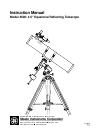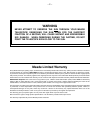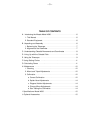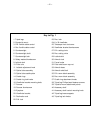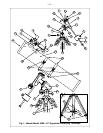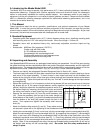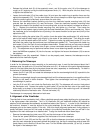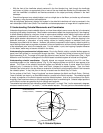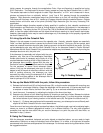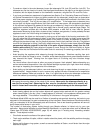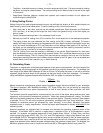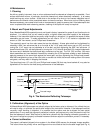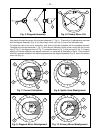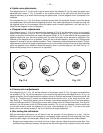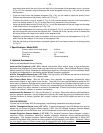
– 7 –
• Release the latitude lock (9) of the equatorial mount, and tilt the polar axis (10) of the telescope to
roughly a 45° angle by turning the latitude adjustment knob (11). With the polar axis thus tilted, firmly
re-tighten the latitude lock.
• Loosen the lock knobs (15) of the cradle rings (14) and open the cradle rings to position them over the
optical tube assembly (12). Turn the lock knobs a few turns to keep the cradle rings closed, but to still
allow the cradle rings to slide freely up-and-down the main tube.
• Remove the viewfinder bracket mounting nuts from the viewfinder bracket mounting bolts (16) that
protrude from the optical tube (12), near the focuser. Place the viewfinder bracket’s mounting holes
(located at the base of the bracket) over the mounting bolts, so that the bracket is oriented as shown in
Fig. 1. Replace the viewfinder bracket mounting nuts, and tighten to a firm feel. Then center the
viewfinder in both bracket rings by backing off the three thumbscrews (26) on each bracket ring. Orient
the viewfinder so its front objective lens is pointing in the same direction as the open end (front) of the
optical tube (25).
• While firmly holding the optical tube (12), position it onto the optical tube saddle plate (13), with the mid-
point of the optical tube’s length lying roughly in the center of the saddle plate. Then slide the cradle
rings (14) over the saddle plate of the mount. Tighten the cradle ring attachment knobs (37) to a firm
feel when the cradle rings are positioned over the telescope’s saddle (13). Then tighten the cradle ring
lock knobs (15) to a firm feel; do not overtighten these knobs. Please note that you may want to change
the rotational position of the optical tube to gain a more comfortable observing position of the focuser
(17). This adjustment may be performed several times in one observing session, as desired.
• Insert the MA25mm eyepiece (19) into the focuser, and tighten the focuser thumbscrew (18) to secure
the eyepiece.
The telescope is now fully assembled. Before it can be properly used, however, the telescope must be
balanced and the viewfinder aligned.
1. Balancing the Telescope
In order for the telescope to move smoothly on its mechanical axes, it must first be balanced about the 2
telescope axes: the polar axis (10) and the Declination axis (21). All motions of the polar aligned telescope
(more on this later) take place by moving about these two axes, separately or simultaneously. To obtain a
fine balance of the telescope, follow the method below:
• Loosen the R.A. lock (22) and rotate the telescope so that the counterweight shaft (6) is parallel to the
ground (horizontal).
• Slide the counterweight along the counterweight shaft until the telescope remains in one position without
tending to drift down in either direction. Then tighten the counterweight lock knob (7), locking the
counterweight in position.
• Lock the R.A. lock (22), and unlock the Declination lock (23). The telescope will now turn freely about
the Declination axis. Loosen the cradle ring lock knobs (15) so that the main tube in the cradle rings
slides easily up-or-down in the cradle rings. Move the main tube in the cradle rings until it is balanced
rotationally about the Declination axis. Re-lock the knobs (15).
The telescope is now properly balanced on both axes.
2. Alignment of the Viewfinder
The wide field of view provided by the 6 x 30mm viewfinder permits easy object sighting prior to observation
in the higher-power main telescope. The 6 x 30 Viewfinder (24) and viewfinder bracket (20) should be
attached to the telescope tube assembly as described above (see Figure 1). In order for the viewfinder to
be functional, however, it must be aligned to the main telescope, so that both the viewfinder and main
telescope point at the same position in the sky. With this simple alignment performed, finding objects is
greatly facilitated, since you will first locate an object in the wide-field viewfinder, then you will look in the
eyepiece of the main telescope for a detailed view. To align the viewfinder follow these steps:
• Remove the telescope front dust cover (25), and the dust covers of the viewfinder.
• Place the low- power (MA25mm) eyepiece into the focuser of the main telescope.
• Unlock the R.A. lock (22) and the Dec. lock (23) so that the telescope turns freely on both axes. Then
point the main telescope at some well-defined land object (e.g. the top of a telephone pole) at least 200
yards distant, and re-lock the R.A and Dec. axes. Turn the flexible cable controls, (3) and (4), to center
the object in the telescopic field.



